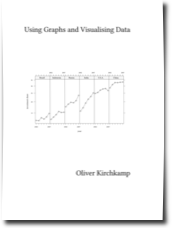![[A picture of Oliver Kirchkamp]](/images/oliver.jpeg)
Graphs and visualising data
The course combines asynchronous and synchronous teaching.I would like students to do two things:
- Watch the videos before the synchronous part starts.
- Think about a graph for your own research project before the synchronous part starts.
- Asynchronous part
- Videos can be found here. It is really essential that you watch the videos before the synchronous part starts.
- Here is the handout.
- Exercises: Think about a graph (or two graphs) for your own research project. Describe what the graph is supposed to show and how it might look. Submit this description four days before the synchronous part starts.
- In the course we will use the statistical programming language R. If you are not familiar with R, you find here some videos on R.
- Synchronous part
- The synchronous part starts on Tuesday, 30 April.
We will discuss the exercises, your questions and your comments.
For this part we will use RStudio and the software mentioned below.
- Motivation
- Graphs and Illustrations can contribute a lot to the success of a scientific paper. In this course we will discuss different ways to use graphs in our research.
- Handout
- Here is a preliminary version of the handout.
- Topics
- Introduction
- Graphs with
ggplot2 - More graphs with
ggplot2 - Nominal data
- Continuous data, distributions
- Continuous data, causal relations, other problems
- (Lattice)
- Literature
-
- William S. Cleveland, “The Elements of Graphing Data”, AT&T Bell Laboratories, New Jersey, 1994.
- Deepayan Sarkar, “Lattice — Multivariate Data Visualization with R”. Springer, New-York, 2008.
- Edward Tufte, “The Visual Display of Quantitative Information”. Bertrams. 2001.
- Hadley Wickham, “ggplot2: Elegant Graphics for Data Analysis (Use R!)”. Springer, New-York, 2016.
- Software
- You should try all the examples on your own computer.
You should have an up-to-date version of R installed. We will also use the following libraries:
aplpack, car, Ecdat, directlabels, dplyr, Hmisc, ggplot2, gridExtra, ggmosaic, ggthemes, ks, lattice, latticeExtra, MASS, mgcv, plotrix, pwt10, reshape2, tidyr, vcd.
